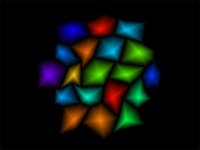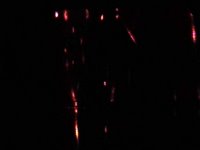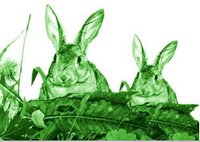 Gordon Monro is an electronic music composer with particular interest in algorithmic and generative art. He is a member of the faculty of the School of Mathematics and Statistics, University of Sydney, and a visiting lecturer in computer music at the Sydney Conservatorium Of Music.
Gordon Monro is an electronic music composer with particular interest in algorithmic and generative art. He is a member of the faculty of the School of Mathematics and Statistics, University of Sydney, and a visiting lecturer in computer music at the Sydney Conservatorium Of Music.http://www.gordonmonro.com/
G.Monro@maths.usyd.edu.au
http://www-personal.usyd.edu.au/~gmonro/
First time I meet Gordon was in early january'06 at a spontaneous music festival in Sydney. I have been wating for him since then because he told me he is coming to Adelaide for Project3 and this presentation.Finally the day has come and he is here..
 Evochord is an installation in which a genetic algorithm tries to evolve a harmonious chord. The visual output consists of coloured shapes, one for each note of the chord; red indicates low, green intermediate and blue high pitches.At any time, what is seen and heard is the single most consonant chord of a population of 100 chords inside the computer.
Evochord is an installation in which a genetic algorithm tries to evolve a harmonious chord. The visual output consists of coloured shapes, one for each note of the chord; red indicates low, green intermediate and blue high pitches.At any time, what is seen and heard is the single most consonant chord of a population of 100 chords inside the computer. What are You Really Thinking ?.. Is a sonification of brainwave data. There are 26 channels of brainwave data from 26 electrodes placed on the subject's(a living being) scalp, and an additional 10 channels of data recording heartbeat, respiration, eye muscle movement, etc.The sounds generated from the scalp electrode data were modified by the data from the other channels.
What are You Really Thinking ?.. Is a sonification of brainwave data. There are 26 channels of brainwave data from 26 electrodes placed on the subject's(a living being) scalp, and an additional 10 channels of data recording heartbeat, respiration, eye muscle movement, etc.The sounds generated from the scalp electrode data were modified by the data from the other channels. Red Grains :An abstract video, with sound created by granular synthesis. His intention was to make an artwork which would give an experience of a waterfall or other natural phenomenon, without imitating an actual natural system.The visuals came from a construction built from two laser pointers, some mirrors and a Lego Robotics kit. The movement of the Lego motors was influenced by two light dependent resistors (LDRs) mounted on the edge of the mirrors, so there was a feedback system.
Red Grains :An abstract video, with sound created by granular synthesis. His intention was to make an artwork which would give an experience of a waterfall or other natural phenomenon, without imitating an actual natural system.The visuals came from a construction built from two laser pointers, some mirrors and a Lego Robotics kit. The movement of the Lego motors was influenced by two light dependent resistors (LDRs) mounted on the edge of the mirrors, so there was a feedback system.-------------------------------------------------------------------------------------------------------------
 Festival Of Spontaneous music
Festival Of Spontaneous musicIf you like improvised music, Contact them..
It's run by Clayton Thomas, Jim Denley and Dale Gorfinkel
contact: clayton(at)thenownow.net with any questions
Forward any questions about the NOW now festival to clare(at)thenownow.net
Post your cds to the following address:
the NOW now
64 Myrtle St
Chippendale 2008
Newtown NSW
Australia 2042
-----------------------------------------------------------------------------------------------------------------
Tyndall Concert 2 : 16 March'06 -- "Shivna Kaun"
Spontaneous Music Perfromance
 Vinny Bhagat : Laptop , field recordings
Vinny Bhagat : Laptop , field recordingsChris Martin : Electric Piano
Kym Gluyas : Video Camera, field recordings.
 End Of Fringe concert: 19 MArch'06 : Shivna Kaun Live at Lizard lounge- Hinley St, Adelaide.
End Of Fringe concert: 19 MArch'06 : Shivna Kaun Live at Lizard lounge- Hinley St, Adelaide.Kym Gluyas : Electronics, field recordings
Vinny Bhagat : Laptop , field recordings
Chris Martin : Electric Piano
Luke Toop : Video Camera,Projections & MIDI Glove
-----------------------------------------------------------------------------------------------------------------
Audio Arts: Gain Structure
When recording any instrument we are trying to achieve cleanest possible sound with minimal noise. To do that it is very important to learn the dynamic range of the instrument you are recording. Dynamic range could be understood as the highest possible undistorted signal to the quietest discernible signal, which is expressed in decibels. Recording above the dynamic range would result in distortion and there can be nothing worse than a digital distortion in your music and likewise recording below means that you are not capturing the signal to its highest limits. While applying any gain to your source, aim for a level below where its starts to peak, where a little safety margin or headroom still remains to accommodate any unexpected signal peaks. We are aiming for a signal before it gets red on the level meter. Any unwanted distortion in your music would only contribute in undesirable results.
Of course microphone placement, distance from the source and patterns of your microphone contribute largely to the end signal you are getting.
Creative programming: Introduction to Max/Msp
Concepts of Max - objects; externals; inlets; outlets; bang; numbers; strings; messages; comments; arguments; patchcords; inspector..Max Tutorials and Topics 1 - 6.
bjective - To introduce students to naturally tempered music, the rich
resultant rhythms and ambience
Forum : Listening To experience a music structured on different principals and to hear unusual sound sources.Introduction tonaturally tempered music, the rich resultant rhythms and ambience
Glenn Branca - Symphony No.3 (Gloria)(1982)
Music for the first 127 intervals of the harmonic series
6 Bowed Electric Guitars & 6 Keyboards and drum set
(guitarists include Sonic Youth's Thurston Moore and Lee Renaldo)
Label - Neutral
Robert Ashley - In Sara, Mencken, Christ and Beethoven there were men and women
(1972)
Text: John Barton Wolgamot
Cramps Records CRSLP 6103
References:
Monro,Gordon 2006..Presentation by Gordon Monro..University Of Adelaide..16 March
Grice, David. 2006. Practical on Gain Structures. University of Adelaide, 28 February.
Haines, Christian. 2006. Practical on Max/Msp.. University of Adelaide, 16 March.
Harris,David.2006.Listening forum.University Of Adelaide,16 March'06
http://www.gordonmonro.com/
Date seen : 1 June'06
http://www.geocities.com/tyndallassembly/ta/concerts/march06.htm
Date seen : 1june'06
http://thenownow.net/festival/default.asp
Date seen : 1 June'06

No comments:
Post a Comment